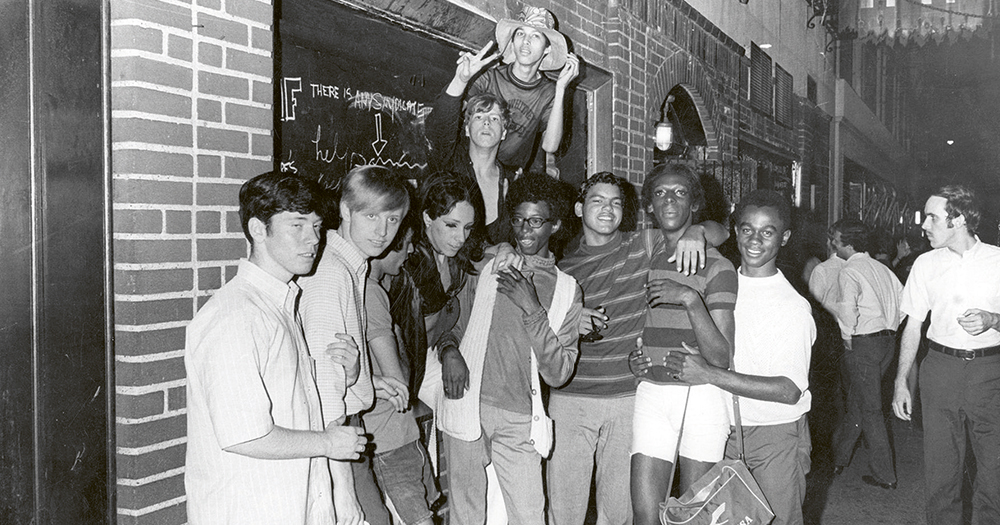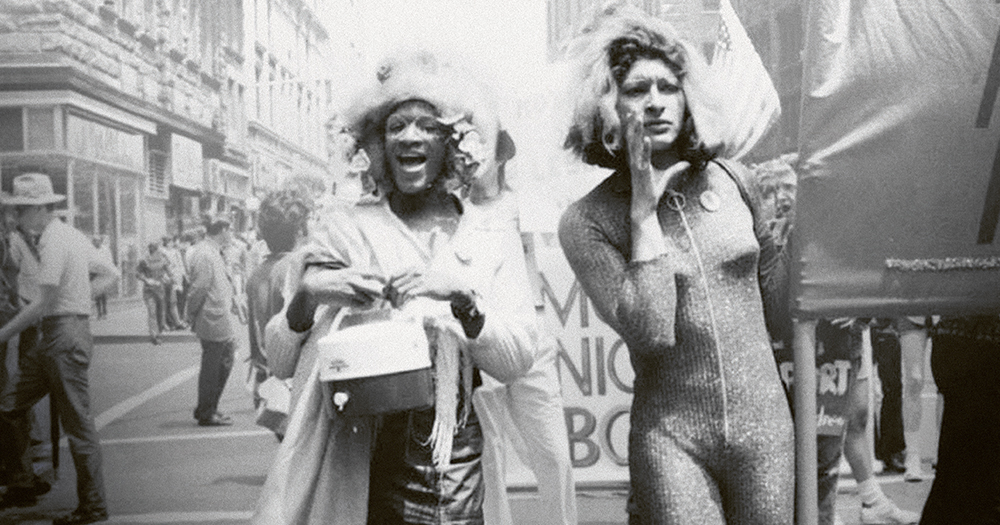While the Stonewall uprising and subsequent riots on the early morning of June 28, 1969, are generally considered the birth of the modern gay liberation movement in the US, there had been a number of demonstrations and acts of civil resistance by LGBT+ people across America since the beginning of the 1950s. To understand the origins of the Stonewall Inn uprising, we need to set it against a wider backdrop of changing social and political movements in post-war America.
I first met Bruce and his husband, John Sheridan, in Cork last June at a meeting called by Cork activists to respond to Ireland’s HIV crisis. Bruce and John were members of an ACT UP chapter in New York in the late ‘80s and some of the founders of ACT UP Cork in July of 2018.

In the 1950’s, social attitudes toward homosexuality were overwhelmingly negative and the psychiatric community regarded homosexuality as a mental disorder.
I start by asking Bruce about life as a gay teenager in America in the early ‘60s; “I grew up in Princeton. I spent a lot of time with my grandparents as my dad was sick for a while. Like a lot of scared gay kids in those days, I tried looking for information on homosexuality in the library but there wasn’t much encouraging information there and it felt dangerous even to be looking for it.
“My childhood was a real suburban situation. At high school I was trying to be Mr Perfect, [I was] an Eagle Scout and state president of the Baptist youth group at my evangelical, yet liberal, church. I was very confused in those days. I remember once after our family moved to a new neighbourhood, I told my Mother that I needed a ‘new boyfriend’. She said I shouldn’t use those words. After high school, there was an expectation that I would go to Princeton college like many in my family, but I chose a small college in Ohio because I wanted to move away and find out who I really was.”
The Lavender Scare was a 1950’s witch hunt which involved the mass firings of gay people from the United States government. It paralleled an earlier anti-communist campaign known as the Red Scare. In the 1950s, social attitudes toward homosexuality were overwhelmingly negative and the psychiatric community regarded homosexuality as a mental disorder.
Gay men and lesbians were considered susceptible to blackmail, therefore a security risk. In 1953, President Dwight D Eisenhower signed Executive Order 10450 which set security standards for federal employment and barred homosexuals from working in the federal government. The executive order was also the cause of about 5,000 gay people being fired from federal employment; this included private contractors and military personnel.
New organisations like the Mattachine Society and the Daughters of Bilitis formed the early gay and lesbian movements in the US. Their primary goals were to unify homosexuals isolated from their own kind and assist gays who were victimised daily as a result of oppression.
“I was at university studying law before Stonewall happened and even the suggestion that you were gay could prevent you from taking the law board exams or getting certified.
Members of the New York chapter of the Mattachine Society aimed to challenge bars that refused service to gay people. These refusals fell under a vague regulation that banned taverns from serving patrons they deemed ‘disorderly’. At that time, being homosexual was, in itself, seen as disorderly.
In April 1966, four members of Mattachine’s New York chapter gained column inches in the New York Times by carrying out a ‘sip-in’ – similar to lunch-counter ‘sit-ins’ used by segregated black patrons during the civil rights movement.
The ‘sip-in’ was when gay activists would announce to bar staff before ordering a drink that they were homosexuals, resulting in the refusal of service. In New Jersey, a Mattachine Society chapter sued bars that refused service to gay people. In 1967, the state’s Supreme Court ruled that “well-behaved homosexuals” could not be denied service.
Bruce remembers this period vividly, “I was at university studying law before Stonewall happened and even the suggestion that you were gay could prevent you from taking the law board exams or getting certified. In fact, anything you were interested in doing could be ruined in a second just by the innuendo that you were gay.
The myth that the patrons of Stonewall rioted because of the death of Judy Garland for instance came from one newspaper report which used the proximity of the Hollywood legend’s funeral to mischaracterise the Stonewall uprising as some kind of gay tantrum.
“Oddly one of the things that helped me come out was the letters section in Playboy Magazine. Playboy printed letters from doctors and psychologists interested in human sexuality. Reading those letters helped me understand that being gay wasn’t as insane as I had been led to believe – it really started to open me up.”
Bruce added, “While at university I had been getting involved in the anti-war movement, going to anti-draft demonstrations and reading lots of literature about national and international liberation movements. Until that moment it hadn’t occurred to me that gay people like me deserved anything but to be downtrodden.
“When I was going to these anti-war marches I would see a banner with GLF (Gay Liberation Front) written on it and there would be a group of drag queens and guys with long hair sitting on a blanket. I thought, ‘Wow, that’s interesting!’ I hadn’t connected gay liberation with the wider civil rights movement but I didn’t get close to it until the summer of 1969.”
The realworld experience was that the people at Stonewall fought back against the police that night and rioted for three subsequent nights.
The events at The Stonewall Inn were covered on radio and in print. However, the accuracy of reporting was often skewed by dismissive voices in the mainstream media. The myth that the patrons of Stonewall rioted because of the death of Judy Garland, for instance, came from one newspaper report which used the proximity of the Hollywood legend’s funeral to mischaracterise the Stonewall uprising as some kind of gay tantrum.
The real-world experience was that the people at Stonewall fought back against the police that night and rioted for three subsequent nights. They did so because a generation of marginalised white, black and Latino LGBT+ people had enough of persecution by the police, government and wider society.
https://www.instagram.com/p/BxGuGYWpVo-/
I saw that damaged Stonewall Inn with barricades still in place. For me, it was ground zero for the gay liberation movement.
Bruce recalls those early reports and of going to see Stonewall in the aftermath. “Within a few weeks, I went into New York’s West Village. I saw that damaged Stonewall Inn with barricades still in place. For me, it was ground zero for the gay liberation movement. For the first time, I realised there was a community living there on Christopher Street, which had pre-existed Stonewall.”
He added, “even outside of New York in the 1970s part of 1969, theatre students at my college in Ohio were talking about creating a gay rights group and calling for a space within the college to meet and organise.”
From 1970 onwards, a new generation of more radical queer people began to picket. Emboldened by action, a diverse mix of subcultures reflected the countercultural movement. The words ‘gay liberation’ echoed ‘women’s liberation’ and the slogan ‘Gay Power’, was inspired by Black Power’s response to the civil rights movement.
Bruce says, “after Stonewall, there were Gay Liberation / Gay Freedom commemoration parades held in New York, LA and San Francisco in the following years, I made my way to New York and met Arthur Bell, Arthur Evans, some of the people that went on to found the Gay Activists Alliance (GAA) at the Firehouse on Wooster Street.”
The realworld experience was that the people at Stonewall fought back against the police that night and rioted for three subsequent nights.
The Gay Activists Alliance (GAA) formed in December 1969 and became an influential American gay liberation political activist group in the early 1970s. It comprised of sub-committees that were named after the issues they were devoted to, for instance; Gay Movement Committee, Lesbian Liberation Committee, Police Power Committee and Youth Information Service committee.
Bruce laughs, “I was a 21 year-old twink, but I was pretty smart, I had studied political philosophy and wanted to talk about it. The thing I enjoyed the most about GAA was the ‘zaps’ – a zap was a public demonstration designed to embarrass a public figure or celebrity while calling the attention of both gays and straights to issues of LGBT+ rights.”
“Having a handle like Stonewall makes it easier for the media to have a narrative, but I can’t over emphasis how important it was
Gay activists began to confront the American Psychiatric Association about its position on homosexuality. There were a series of dramatic encounters between activists and psychiatrists at the annual meetings of the APA between 1970 and 1972. The APA removed homosexuality from its Manual of Mental Disorders in 1973.
Throughout the 1970’s, LGBT+ groups and activists paved the way for sweeping changes in the US. In 1978, Harvey Milk made national news when he was sworn in as a member of the San Francisco Board of Supervisors. In October 1979, about 75,000 people participated in the National March on Washington for Lesbian and Gay Rights. It was the largest political gathering in support of LGBT+ rights to date.
I ask Bruce about the significance of Stonewall today and the way it’s reported in the media. Bruce says, “Having a handle like Stonewall makes it easier for the media to have a narrative, but I can’t over emphasise how important it was.”
© 2019 GCN (Gay Community News). All rights reserved.
Support GCN
GCN is a free, vital resource for Ireland’s LGBTQ+ community since 1988.
GCN is a trading name of National LGBT Federation CLG, a registered charity - Charity Number: 20034580.
GCN relies on the generous support of the community and allies to sustain the crucial work that we do. Producing GCN is costly, and, in an industry which has been hugely impacted by rising costs, we need your support to help sustain and grow this vital resource.
Supporting GCN for as little as €1.99 per month will help us continue our work as Ireland’s free, independent LGBTQ+ media.
